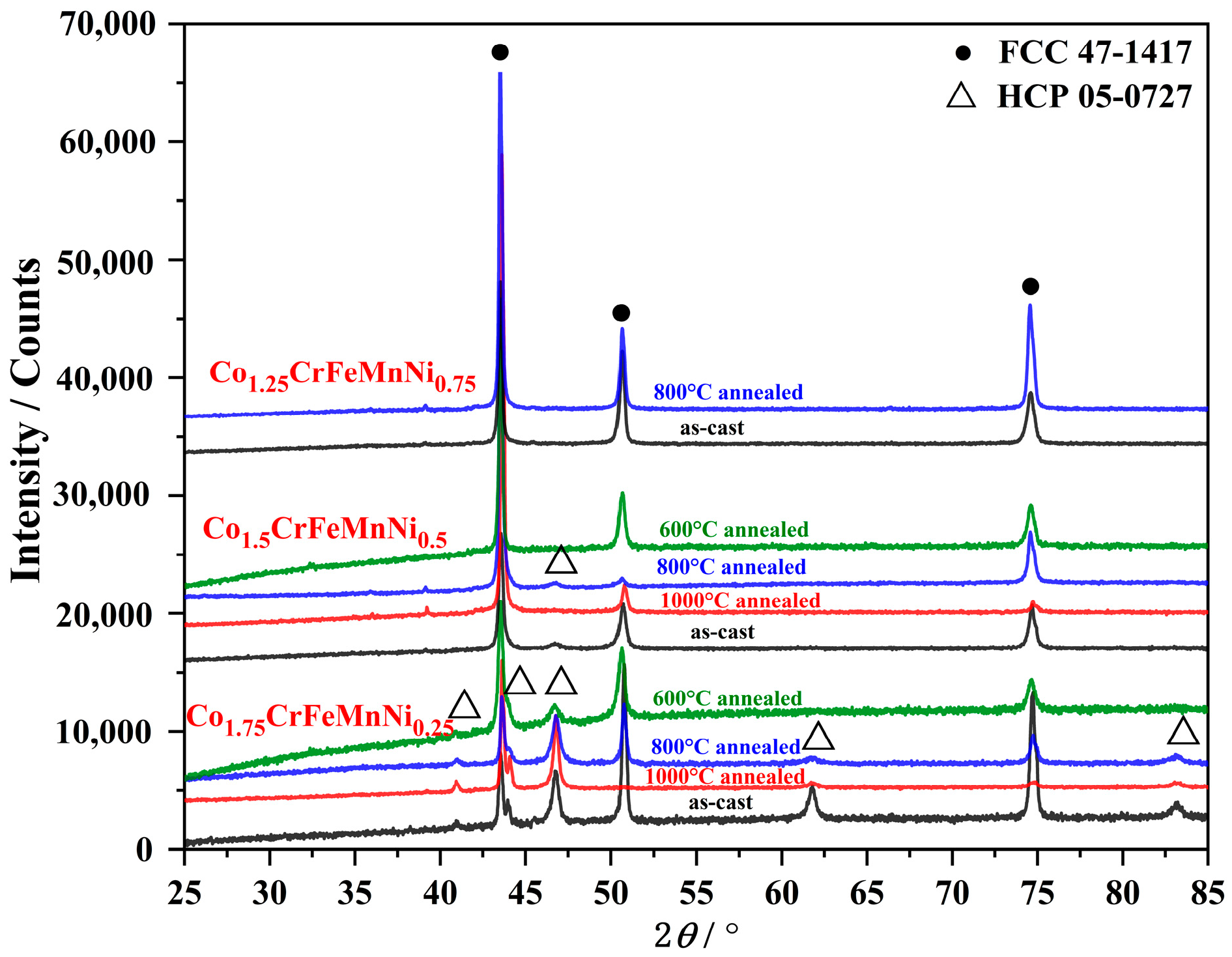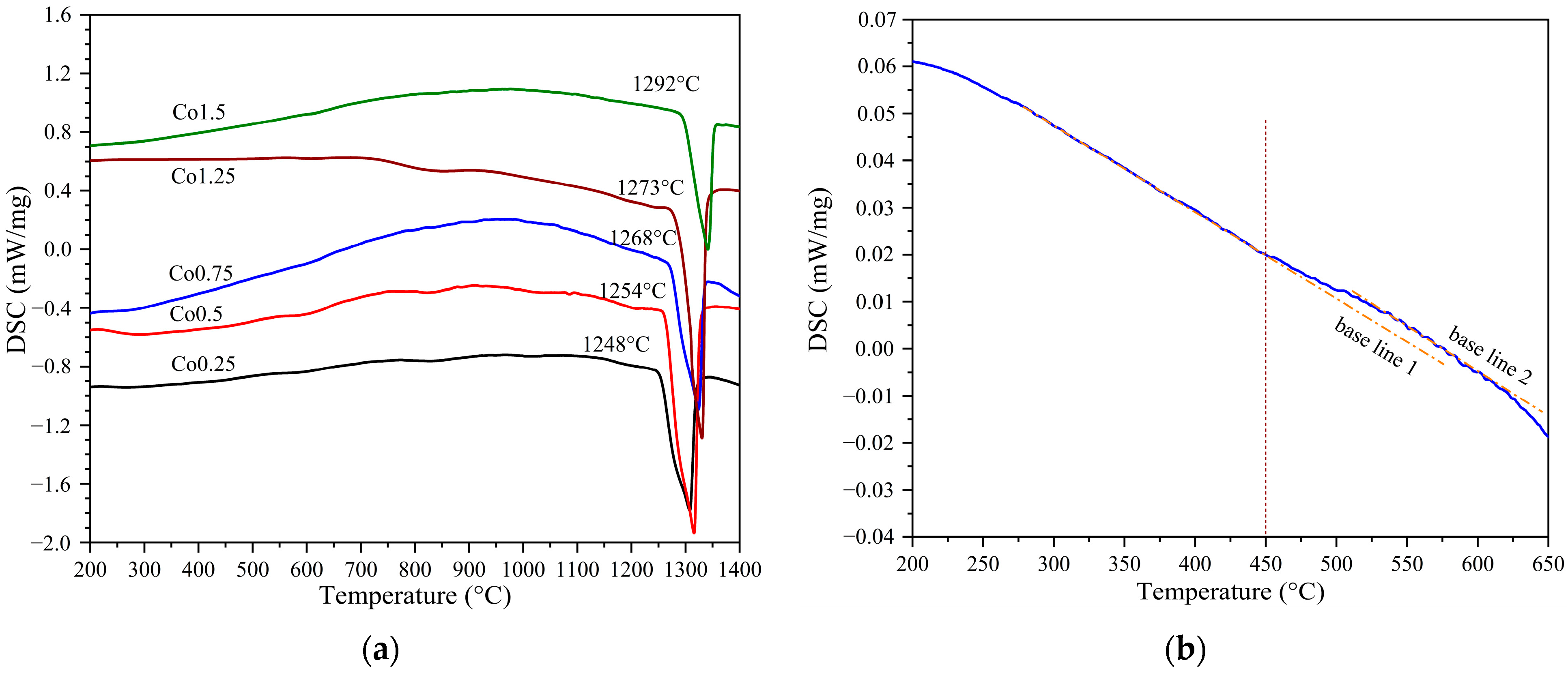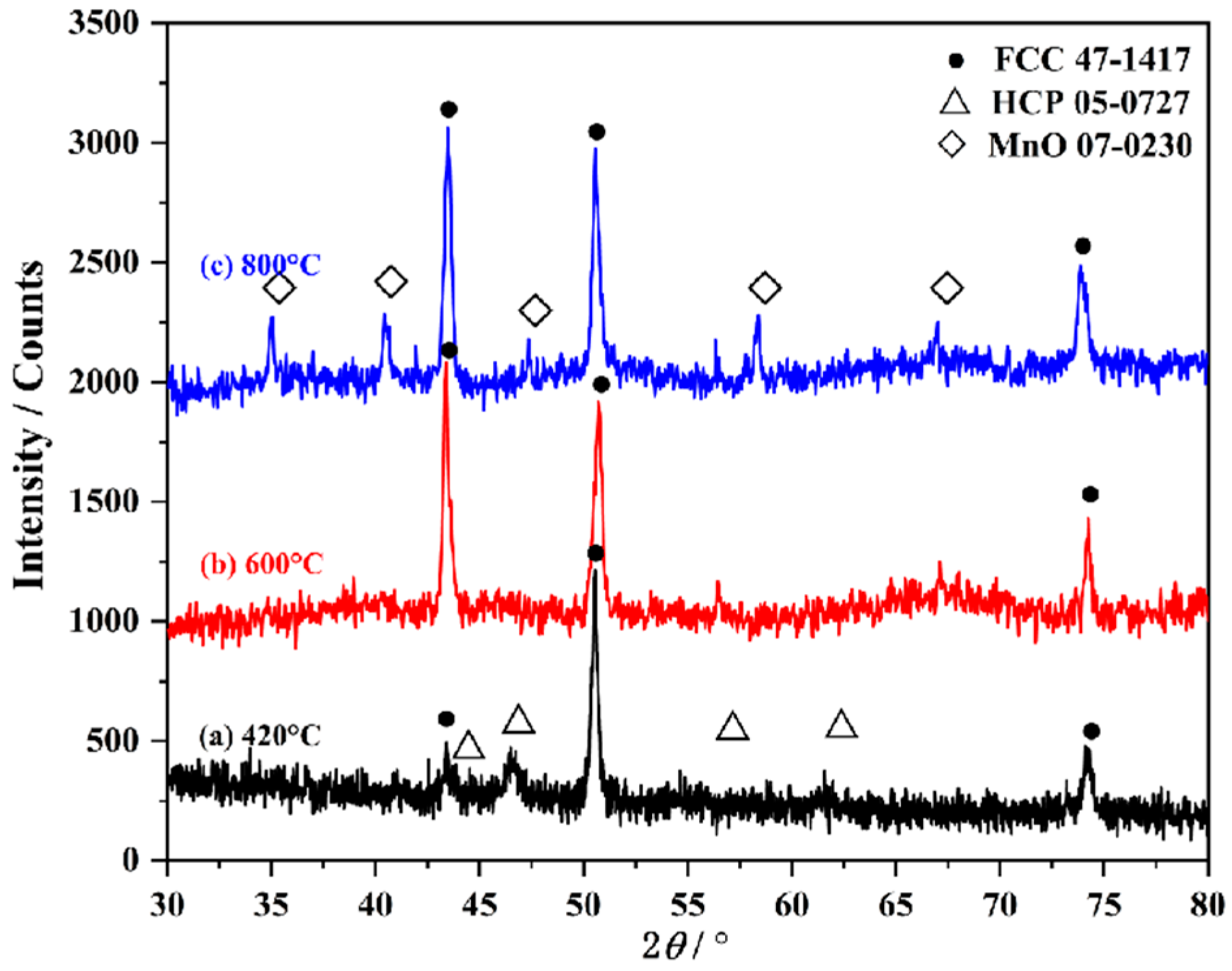Insight into the FCC→HCP Transformation in Co-Rich Co-Cr-Fe-Mn-Ni High-Entropy Alloys
Abstract
1. Introduction
2. Materials and Methods
3. Results
3.1. Phase Constituents of the As-Cast CoxCrFeNi2−x Alloys
3.2. DSC Examination
3.3. High-Temperature XRD Examination
3.4. Phase Diagram
3.5. Alloy Hardness
3.6. First-Principle Calculations
4. Discussion
5. Conclusions
- When x ≥ 1.5, the FCC and HCP phases coexist in the Co-rich CoxCrFeMnNi2−x alloys at room temperature. They have the same chemical composition, and the volume fraction of the HCP phase increases with Co content.
- It is confirmed that, in the Co1.75CrFeMnNi0.25 alloy, the HCP phase forms during cooling with an FCC→HCP transition around 450 °C. The HCP phase is not stable above 600 °C.
- As for the Co1.75CrFeMnNi0.25 alloy, the HCP structure is more stable than the FCC structure and has a higher bulk modulus.
- The microhardness of Co1.75CrFeMnNi0.25 numero HCP phase reaches 213 HV and is much higher than the other alloys that do not contain an HCP phase, either in their as-cast states or after annealing. The FCC→HCP transformation should improve the alloy’s mechanical properties.
Author Contributions
Funding
Data Availability Statement
Conflicts of Interest
References
- Mishra, R.K.; Kumari, P.; Gupta, A.K.; Shahi, R.R. Design and development of Co35Cr5Fe20−xNi20+xTi20 High Entropy Alloy with excellent magnetic softness. J. Alloys Compd. 2022, 889, 161773. [Google Scholar] [CrossRef]
- Shi, P.; Li, R.; Li, Y.; Wen, Y.; Zhong, Y.; Ren, W.; Shen, Z.; Zheng, T.; Peng, J.; Liang, X.; et al. Hierarchical crack buffering triples ductility in eutectic herringbone high-entropy alloys. Science 2021, 373, 912–918. [Google Scholar] [CrossRef]
- Bracq, G.; Laurent-Brocq, M.; Perrière, L.; Pirès, R.; Joubert, J.-M.; Guillot, I. The fcc solid solution stability in the Co-Cr-Fe-Mn-Ni multi-component system. Acta Mater. 2017, 128, 327–336. [Google Scholar] [CrossRef]
- Yeh, J.-W. Alloy Design Strategies and Future Trends in High-Entropy Alloys. JOM 2013, 65, 1759–1771. [Google Scholar] [CrossRef]
- Tsai, K.Y.; Tsai, M.H.; Yeh, J.W. Sluggish diffusion in Co-Cr-Fe-Mn-Ni high-entropy alloys. Acta Mater. 2013, 61, 4887–4897. [Google Scholar] [CrossRef]
- Cao, X.; Wu, C.; Liu, Y.; Peng, H.; Su, X. Eutectic Reaction and Microstructure Stability in CoCrFeNiNbx High-Entropy Alloys. Metals 2022, 12, 756. [Google Scholar] [CrossRef]
- Santodonato, L.J.; Zhang, Y.; Feygenson, M.; Parish, C.M.; Gao, M.C.; Weber, R.J.; Neuefeind, J.C.; Tang, Z.; Liaw, P.K. Deviation from high-entropy configurations in the atomic distributions of a multi-principal-element alloy. Nat. Commun. 2015, 6, 5964. [Google Scholar] [CrossRef]
- Tian, M.; Wu, C.; Liu, Y.; Peng, H.; Wang, J.; Su, X. Phase stability and microhardness of CoCrFeMnxNi2-x high entropy alloys. J. Alloys Compd. 2019, 811, 152025. [Google Scholar] [CrossRef]
- Pradeep, K.G.; Tasan, C.C.; Yao, M.J.; Deng, Y.; Springer, H.; Raabe, D. Non-equiatomic high entropy alloys: Approach towards rapid alloy screening and property-oriented design. Mater. Sci. Eng. A 2015, 648, 183–192. [Google Scholar] [CrossRef]
- Youssef, K.M.; Zaddach, A.J.; Niu, C.; Irving, D.L.; Koch, C.C. A Novel Low-Density, High-Hardness, High-entropy Alloy with Close-packed Single-phase Nanocrystalline Structures. Mater. Res. Lett. 2015, 3, 95–99. [Google Scholar] [CrossRef]
- Senkov, O.N.; Senkova, S.V.; Woodward, C. Effect of aluminum on the microstructure and properties of two refractory high-entropy alloys. Acta Mater. 2014, 68, 214–228. [Google Scholar] [CrossRef]
- Laurent-Brocq, M.; Perrière, L.; Pirès, R.; Champion, Y. From high entropy alloys to diluted multi-component alloys: Range of existence of a solid-solution. Mater. Des. 2016, 103, 84–89. [Google Scholar] [CrossRef]
- Cantor, B.; Chang, I.T.H.; Knight, P.; Vincent, A.J.B. Microstructural development in equiatomic multicomponent alloys. Mater. Sci. Eng. A 2004, 375–377, 213–218. [Google Scholar] [CrossRef]
- Gludovatz, B.; Hohenwarter, A.; Catoor, D.; Chang, E.H.; George, E.P.; Ritchie, R.O. A fracture-resistant high-entropy alloy for cryogenic applications. Science 2014, 345, 1153–1158. [Google Scholar] [CrossRef] [PubMed]
- Kawamura, M.; Asakura, M.; Okamoto, N.L.; Kishida, K.; Inui, H.; George, E.P. Plastic deformation of single crystals of the equiatomic Cr-Mn-Fe-Co-Ni high-entropy alloy in tension and compression from 10 K to 1273 K. Acta Mater. 2021, 203, 116454. [Google Scholar] [CrossRef]
- Wei, D.; Li, X.; Jiang, J.; Heng, W.; Koizumi, Y.; Choi, W.-M.; Lee, B.-J.; Kim, H.S.; Kato, H.; Chiba, A. Novel Co-rich high performance twinning-induced plasticity (TWIP) and transformation-induced plasticity (TRIP) high-entropy alloys. Scr. Mater. 2019, 165, 39–43. [Google Scholar] [CrossRef]
- Wagner, C.; Ferrari, A.; Schreuer, J.; Couzinié, J.-P.; Ikeda, Y.; Körmann, F.; Eggeler, G.; George, E.P.; Laplanche, G. Effects of Cr/Ni ratio on physical properties of Cr-Mn-Fe-Co-Ni high-entropy alloys. Acta Mater. 2022, 227, 117693. [Google Scholar] [CrossRef]
- Wei, D.; Li, X.; Heng, W.; Koizumi, Y.; He, F.; Choi, W.-M.; Lee, B.-J.; Kim, H.S.; Kato, H.; Chiba, A. Novel Co-rich high entropy alloys with superior tensile properties. Mater. Res. Lett. 2019, 7, 82–88. [Google Scholar] [CrossRef]
- Guo, S.; Ng, C.; Lu, J.; Liu, C.T. Effect of valence electron concentration on stability of fcc or bcc phase in high entropy alloys. J. Appl. Phys. 2011, 109, 103505. [Google Scholar] [CrossRef]
- Fang, W.; Yu, H.; Chang, R.; Zhang, X.; Ji, P.; Liu, B.; Li, J.; Qu, X.; Liu, Y.; Yin, F. Microstructure and mechanical properties of Cr-rich Co-Cr-Fe-Ni high entropy alloys designed by valence electron concentration. Mater. Chem. Phys. 2019, 238, 121897. [Google Scholar] [CrossRef]
- Chung, D.H.; Kim, W.C.; Baek, S.Y.; Kim, M.H.; Na, Y.S. Thermodynamics-based design strategy for optimizing strength and ductility of Cr-Ni-Mn-Fe medium-entropy alloys. J. Alloys Compd. 2022, 899, 163331. [Google Scholar] [CrossRef]
- Schuh, B.; Mendez-Martin, F.; Völker, B.; George, E.P.; Clemens, H.; Pippan, R.; Hohenwarter, A. Mechanical properties, microstructure and thermal stability of a nanocrystalline CoCrFeMnNi high-entropy alloy after severe plastic deformation. Acta Mater. 2015, 96, 258–268. [Google Scholar] [CrossRef]
- De Cooman, B.C.; Estrin, Y.; Kim, S.K. Twinning-induced plasticity (TWIP) steels. Acta Mater. 2018, 142, 283–362. [Google Scholar] [CrossRef]
- Fang, W.; Chang, R.; Ji, P.; Zhang, X.; Liu, B.; Qu, X.; Yin, F. Transformation Induced Plasticity Effects of a Non-Equal Molar Co-Cr-Fe-Ni High Entropy Alloy System. Metals 2018, 8, 369. [Google Scholar] [CrossRef]
- Wang, Q.; Wu, C.; Xu, X.; Peng, H.; Liu, Y.; Su, X. Effect of Annealing on Microstructure and Corrosion resistance of the CoxCrFeMnNi2-x High-entropy Alloys. Mater. Rep. 2022, 36, 21110150. [Google Scholar]
- Tian, M.; Wu, C.; Liu, Y.; Peng, H.; Wang, J.; Su, X. Phase stability of the CoxMn2-xCrFeNi high entropy alloys. Mater. Rep. 2020, 34, 17067–17071. [Google Scholar]
- Zhang, F.X.; Zhao, S.; Jin, K.; Bei, H.; Popov, D.; Park, C.; Neuefeind, J.C.; Weber, W.J.; Zhang, Y. Pressure-induced fcc to hcp phase transition in Ni-based high entropy solid solution alloys. Appl. Phys. Lett. 2017, 110, 011902. [Google Scholar] [CrossRef]
- Gao, X.; Chen, R.; Liu, T.; Fang, H.; Wang, L.; Su, Y. High deformation ability induced by phase transformation through adjusting Cr content in Co-Fe-Ni-Cr high entropy alloys. J. Alloys Compd. 2022, 895, 162564. [Google Scholar] [CrossRef]
- Tian, F. A Review of Solid-Solution Models of High-Entropy Alloys Based on Ab Initio Calculations. Front. Mater. 2017, 4, 36. [Google Scholar] [CrossRef]
- Mu, Y.; Liu, H.; Liu, Y.; Zhang, X.; Jiang, Y.; Dong, T. An ab initio and experimental studies of the structure, mechanical parameters and state density on the refractory high-entropy alloy systems. J. Alloys Compd. 2017, 714, 668–680. [Google Scholar] [CrossRef]
- Bellaiche, L.; Vanderbilt, D. Virtual crystal approximation revisited: Application to dielectric and piezoelectric properties of perovskites. Phys. Rev. B 2000, 61, 7877–7882. [Google Scholar] [CrossRef]
- King, D.J.M.; Burr, P.A.; Obbard, E.G.; Middleburgh, S.C. DFT study of the hexagonal high-entropy alloy fission product system. J. Nucl. Mater. 2017, 488, 70–74. [Google Scholar] [CrossRef]
- Gao, Y.; Qiao, L.; Wu, D.; Zhang, Y.; Zou, Y. First principle calculation of the effect of Cr, Ti content on the properties of VMoNbTaWMx (M = Cr, Ti) refractory high entropy alloy. Vacuum 2020, 179, 109459. [Google Scholar] [CrossRef]
- Tran, N.-D.; Saengdeejing, A.; Suzuki, K.; Miura, H.; Chen, Y. Stability and Thermodynamics Properties of CrFeNiCoMn/Pd High Entropy Alloys from First Principles. J. Phase Equilibria Diffus. 2021, 42, 606–616. [Google Scholar] [CrossRef]
- Liang, F.; Du, J.; Su, G.S.; Xu, C.H.; Zhang, C.Y.; Kong, X.M. Phase stability and mechanical properties analysis of AlCoxCrFeNi HEAs based on first principles. Metals 2022, 12, 1860. [Google Scholar] [CrossRef]
- Wu, C.; Zhou, C.; Liu, Y.; Peng, H.; Wang, J.; Su, X. Effects of vacuum annealing on the phase constituents and mechanical properties of the AlxCrFeMn2-xNi multiprincipal component alloys. Vacuum 2022, 199, 110934. [Google Scholar] [CrossRef]
- Wu, C.; Sun, Y.; Liu, Y.; Tu, H. Effect of Long-Time Annealing at 1000 °C on Phase Constituent and Microhardness of the 20Co-Cr-Fe-Ni Alloys. Materials 2019, 12, 1700. [Google Scholar] [CrossRef]
- Chen, H.-L.; Mao, H.; Chen, Q. Database development and Calphad calculations for high entropy alloys: Challenges, strategies, and tips. Mater. Chem. Phys. 2018, 210, 279–290. [Google Scholar] [CrossRef]
- Edalati, P.; Mohammadi, A.; Tang, Y.; Floriano, R.; Fuji, M.; Edalati, K. Phase transformation and microstructure evolution in ultrahard carbon-doped AlTiFeCoNi high-entropy alloy by high-pressure torsion. Mater. Lett. 2021, 302, 130368. [Google Scholar] [CrossRef]
- Li, X.; Irving, D.L.; Vitos, L. First-principles investigation of the micromechanical properties of fcc-hcp polymorphic high-entropy alloys. Sci. Rep. 2018, 8, 11196. [Google Scholar] [CrossRef]
- Wang, R.; Tang, Y.; Li, S.; Bai, S. Research progress on deformation mechanisms under dynamic loading of high-entropy alloys. Mater. Rep. 2021, 35, 17001–17009. [Google Scholar]
- Chen, J.; Feng, Z.; Jianhong, Y. Coordination deformation mechanism between dislocation and twin in CrCoNi medium entropy alloy. Mater. Rep. 2022, 36, 20090129. [Google Scholar]






| Alloys | States | Phases | Detected Composition (at.%) | ||||
|---|---|---|---|---|---|---|---|
| Co | Cr | Fe | Mn | Ni | |||
| Co25Ni15 | as-cast | FCC | 25.2 | 19.8 | 20.0 | 20.7 | 14.3 |
| 1000 °C annealed | FCC | 23.8 | 19.8 | 19.2 | 20.9 | 16.3 | |
| 800 °C annealed | FCC | 25.7 | 19.7 | 20.4 | 20.7 | 13.5 | |
| BCC | 6.9 | 68.9 | 7.0 | 12.4 | 4.7 | ||
| Co30Ni10 | as-cast | FCC/HCP | 31.1 | 20.9 | 22.3 | 16.5 | 9.2 |
| 1000 °C annealed | FCC | 31.1 | 21.6 | 21.0 | 16.4 | 9.9 | |
| 800 °C annealed | FCC | 31.2 | 20.6 | 19.7 | 19.3 | 9.2 | |
| BCC | 17.7 | 47.5 | 13.5 | 15.5 | 5.9 | ||
| Co35Ni5 | as-cast | FCC/HCP | 35.1 | 19.9 | 19.9 | 20.2 | 4.9 |
| 1000 °C annealed | FCC/HCP | 37.0 | 19.3 | 19.6 | 18.9 | 5.2 | |
| 800 °C annealed | FCC/HCP | 35.1 | 19.7 | 19.9 | 20.2 | 5.1 | |
| Structure | Lattice Constant/Å | Elastic Constant/GPa | Total Energy/eV/atom | Bulk Modulus/GPa | Young’s Modulus /GPa | ||||
|---|---|---|---|---|---|---|---|---|---|
| C11 | C12 | C13 | C33 | C44 | |||||
| FCC | a = 3.4870 | 298.09 | 139.91 | — | — | 150.80 | −1166.07 | 192.63 | 278.62 |
| HCP | a = 2.4828 c = 3.9783 | 387.04 | 130.55 | 108.95 | 395.41 | 89.23 | −1166.08 | 207.33 | 283.43 |
Disclaimer/Publisher’s Note: The statements, opinions and data contained in all publications are solely those of the individual author(s) and contributor(s) and not of MDPI and/or the editor(s). MDPI and/or the editor(s) disclaim responsibility for any injury to people or property resulting from any ideas, methods, instructions or products referred to in the content. |
© 2023 by the authors. Licensee MDPI, Basel, Switzerland. This article is an open access article distributed under the terms and conditions of the Creative Commons Attribution (CC BY) license (https://creativecommons.org/licenses/by/4.0/).
Share and Cite
Wang, Y.; Wu, C.; Liu, Y.; Tian, M.; Lu, X.; Su, X. Insight into the FCC→HCP Transformation in Co-Rich Co-Cr-Fe-Mn-Ni High-Entropy Alloys. Metals 2023, 13, 504. https://doi.org/10.3390/met13030504
Wang Y, Wu C, Liu Y, Tian M, Lu X, Su X. Insight into the FCC→HCP Transformation in Co-Rich Co-Cr-Fe-Mn-Ni High-Entropy Alloys. Metals. 2023; 13(3):504. https://doi.org/10.3390/met13030504
Chicago/Turabian StyleWang, Yuchen, Changjun Wu, Ya Liu, Mengyun Tian, Xiaowang Lu, and Xuping Su. 2023. "Insight into the FCC→HCP Transformation in Co-Rich Co-Cr-Fe-Mn-Ni High-Entropy Alloys" Metals 13, no. 3: 504. https://doi.org/10.3390/met13030504
APA StyleWang, Y., Wu, C., Liu, Y., Tian, M., Lu, X., & Su, X. (2023). Insight into the FCC→HCP Transformation in Co-Rich Co-Cr-Fe-Mn-Ni High-Entropy Alloys. Metals, 13(3), 504. https://doi.org/10.3390/met13030504





